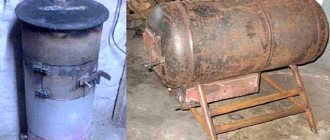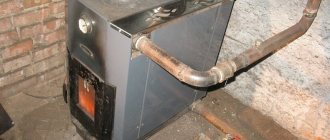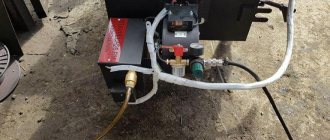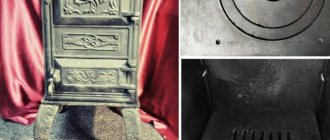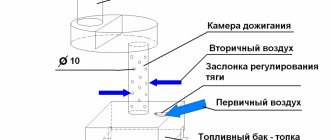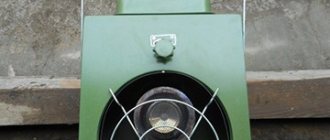Used oil is a proven fuel that can be used to heat small spaces. Recently it has become less profitable, but it is suitable for small warehouses, garages or utility blocks where fuel consumption is low.
An oil stove is an inexpensive way to heat the average garage. The material for the firebox is not difficult to find, and you can assemble it yourself in a matter of hours. It is not difficult to assemble the unit; it is made from scrap materials.
For refueling, regular motor oil is used, which can be drained from the car. Compared to expensive diesel heating devices, there is no need to buy diesel separately.
Furnace in production: options for making the device yourself
With the approach of cold weather, many craftsmen are coming up with various designs for heating the room and heating water. First of all, the question is about the type of fuel. In search of the most rational and cheapest option, many choose to work off, the average consumption of which is about 2 liters per hour. A waste oil furnace has a number of advantages. Knowing all the intricacies of its manufacture, you can create a budget-friendly and efficient source of heat in the house. Garage stove: photo examples, varieties, how to make it yourself (read more)
Creating a homemade stove for mining is not a labor-intensive process.
Advantages and disadvantages of a waste oil stove
A factory or homemade waste oil furnace is characterized by a number of advantages:
- ensuring fast and efficient heating of enclosed spaces in the form of greenhouses, domestic buildings, warehouses and technical rooms;
- independence of the device from electricity and gas;
When ensuring normal operation, the stove does not create a lot of soot and burning.
- unique design features of the device that allow you to carry out the cooking process;
- ease of operation;
- no open flame;
- reliability of the structure, which is made of metal products connected by welding;
- when ensuring normal operation, the stove does not create a lot of soot and burning;
- due to its light weight and dimensions, the device can be transported;
- the stove can be made from scrap metal;
- during operation of the device, combustion of oil and its vapor is ensured;
- The stove can be combined with a water heating system by installing a tank on top.
A closed type furnace is not without its drawbacks, among which are the following:
- the possibility of clogging the supply tube with waste oil;
- the need to install a chimney with a length of at least 4 m;
- presence of hot open surfaces;
The exhaust furnace provides fast and efficient heating of various types of enclosed spaces.
- weekly cleaning of the chimney and oil container from accumulated waste;
- high probability of contamination of clothing and premises during contact with fuel;
- the container with fuel should be located in a warm room;
- unpleasant smell of used oil;
- the flame in the apparatus can be extinguished only after the fuel has completely burned out;
- if used incorrectly, the fire hazard increases;
- characteristic humming noise during operation of the furnace;
- The fuel ignites only when it is heated to its flash point.
Note! Before pouring oil into the system, it should be filtered.
Where to apply and how to modify
Due to a significant list of disadvantages, waste oil heaters are rarely used in housing. But they are widely used for heating technical and production areas. Motorists use them in garages, gardeners - in greenhouses, livestock breeders - in outbuildings. There is always a place for them at car washes, service stations, and warehouses where there are no flammable materials.
Often basic designs are subject to various kinds of modifications. For example, a water jacket or water heating coils are used for these purposes. Such equipment is included in water heating. Furnaces of this type must operate using automation, otherwise their functioning will have to be closely monitored.
Operating principle of a waste oil furnace
The prototype for oil furnaces operating on waste oil is kerogas, which was previously used in villages and dachas. It used kerosene as fuel, the vapors of which were burned in a separate chamber. To save on fuel, a waste oil burning option was developed. It can be purchased for free or at a reasonable cost at any service station.
Components of a waste oil stove.
Creating a homemade stove during mining is not a difficult process. The main task is to properly organize the system for a productive oil combustion process. To ensure complete combustion of vapors, heavy components must first be split into light ones, which is carried out as a result of pyrolysis. The oil must be properly heated for efficient evaporation.
The operating principle of an oil furnace during mining is as follows. First of all, the mining is ignited in the lower chamber of the apparatus. The combustion intensity is regulated using a throttle valve in the device body, through which air enters the chamber. Oil vapor mixed with oxygen rises upward through a vertical pipe. The pipe is connected to the upper tank, which is the afterburner chamber.
The mixture is mixed under the influence of the Coriolis force (force of inertia). The intensity of the process is achieved by choosing the correct diameter and length of the combustion chamber. To ensure complete combustion, air must flow through the damper in sufficient quantity. To do this, it is additionally sucked through holes made in a vertical perforated pipe connecting the tanks.
The combustion intensity is regulated using a throttle valve in the device body.
The gas flow is directed to the final combustion chamber, in which the upper part is expanded. During its manufacture, a horizontal separation is made between the chimney inlet and the combustion chamber outlet, which is necessary to ensure a temperature jump between the nitrogen oxide and oxygen afterburning zones. At temperatures below 600 °C, nitrogen oxides are more active than oxygen. As they decompose, they oxidize fuel particles. With increasing temperature, oxygen acts as the main oxidizing agent. Harmful substances are released into the atmosphere through the chimney.
Note! To ensure efficient oil combustion in the upper tank, the temperature must be low.
Comparison with modern models
As for today's stoves, they are not at all similar to the old prototypes, with the exception of the potbelly stove, which retains the original principle of operation. In the sixties of the last century, the combustion of fuel to the state of carbon dioxide and water vapor was not considered something harmful, which cannot be said about the present time. Now any greenhouse gases are a dangerous enemy of the environment, so people are trying to abandon systems that pollute the environment. It is still impossible to ensure complete afterburning of the waste, but achieving maximum efficiency is quite possible.
Modern oil furnaces are different from the original ones
Also, in the distant past, there were no motor oils on the market with synthetic additives and clever additives, which can reduce the fuel consumption of internal combustion engines several times, but if burned incorrectly, they release carcinogens, toxic substances and mutagens. And people then were more resistant to various environmental influences, and the population was about 2.5 times smaller than now.
And in the end, Soviet engine oil was a natural petroleum product made on the basis of saturated carbons, which could not reach a high combustion temperature. This means that the appearance of harmful and dangerous nitrogen oxides in those heaters was practically eliminated. Modern installations emit such substances in significant quantities, which forces us to look for cleaner and alternative solutions.
Waste oil furnace: types of designs
There are several types of oil furnaces that operate on waste oil. The classic model is the pyrolysis apparatus. It is made from ready-made containers in the form of barrels, pipes, cylinders or from alloy sheets. Oil is poured into the lower vessel, which splits when there is insufficient air. In the upper tank, intensive combustion of its vapor occurs, due to which a lot of heat is released.
Temperature regulation is carried out by air supply. Such a furnace requires constant cleaning of the chambers from accumulated fractions. It does not have mechanical temperature control.
Oil is poured into the lower vessel of the stove, which breaks down when there is insufficient air.
At the oil recovery stove, a guaranteed air supply to the second chamber is realized with the help of a fan. The combustion process is more efficient, so warm air evenly enters the room.
The operating principle of a stove with a drip supply of fuel is similar to the operating mechanism of diesel engines. It is economical. However, the independent process of manufacturing the device is very labor-intensive, so it is better to purchase a factory device of this type. In addition, it should be taken into account that homemade drip stoves are picky about the quality of the oil, which must be preheated before feeding into the stove.
The most efficient model is a supercharged waste oil furnace. It, in comparison with a potbelly stove, has a higher cost. Additional heat comes from blowing fans. Supercharging can be done using a car cooler motor, and the heater is blown by a 220 V home propeller.
Standard layout of a waste oil furnace.
Potbelly stove in the garage: pros and cons
Car enthusiasts install a homemade potbelly stove in the garage for several reasons:
- the stove heats the room in winter;
- you can cook food or heat a kettle on a potbelly stove;
- With a design approach, a homemade heating device can become a decoration for the garage.
We advise you to read in more detail why a potbelly stove smokes and find answers to your questions.
A potbelly stove has a number of advantages compared to other heating devices:
- For kindling, you can use a variety of fuels - firewood, coals, construction waste, petroleum products, waste oil, etc.
- The main advantage of a potbelly stove is the speed of heating the room. Thanks to its high efficiency and power, the stove will heat a garage of 50-60 square meters. m. in 15-20 minutes.
- The stove distributes heat evenly regardless of where it is located.
- A potbelly stove is an economical heating device. For example, heating a garage with a potbelly stove will cost several times less than with an electric heater.
- An additional advantage of a potbelly stove in the garage is the ability to cook or warm up food. When creating a stove yourself, it is enough to attach a metal cooking surface to its upper part.
- A homemade stove will cost the car owner almost free if there is an unnecessary barrel, sheet of metal and pipe lying around in the garage.
We previously wrote an article about installing a potbelly stove for heating and recommended adding it to your bookmarks.
The potbelly stove will fit harmoniously into the interior of any garage. In addition to the heating function, the heating device has a “cooking mode”. A hob is installed at the top of the stove, where you can heat a kettle or cook food.
The disadvantages of a potbelly stove in the garage are:
- the need to install a chimney in the garage;
- periodic cleaning of the chimney;
- the need for constant fuel supply;
- inability to accumulate heat.
Requirements for installation and operation of an oil furnace
It is required that the stove be located in an empty room, near which there should be no flammable surfaces. Particular attention is paid to self-made devices. They should not be placed on a shelf or other support that could catch fire.
A homemade furnace for mining should be located on a flat base, which can be concrete or brick. It is necessary that the distance between the apparatus and the wall be at least 1 m. To create good draft, the chimney must have a length of more than 4 m. Insulation should be provided on its external side to prevent the formation of acid condensation.
The used oil should not contain any solvent or other flammable element, so such components should be kept away from the furnace. It is also unacceptable for moisture to get into the container with oil. This will cause a fire in the oven. In the event of an emergency, a fire extinguisher should be used to extinguish the fire.
Note! In the room where the stove is located, there must be a good system of natural supply and exhaust ventilation.
The operating principle of a stove with a drip supply of fuel is similar to the operating mechanism of diesel engines.
Before starting work, oil is poured into a container in an amount equal to half the volume of the tank, which will provide the necessary space for the formation of vapor. For the vapors to become enriched with oxygen, you need to wait some time. Then the fuel is ignited using long matches. As soon as the process of ignition of vapors begins, the damper is closed halfway.
To increase the performance of the mini-furnace during mining, you can install a sealed tank with liquid above its upper chamber. To supply and drain water, fittings are attached to it, which are located at different levels. Another option for increasing productivity is the necessary air convection, which is carried out using a fan located near the upper chamber. By taking warm air from the stove, it helps to cool it, which has a positive effect on the life of the device.
DIY options for increasing the efficiency of a mini-oven
Waste oil furnaces are often used to heat a garage or small workshop. It is not recommended to use such a device in a building where people are constantly present. This is due to the fact that the stove absorbs oxygen, which has a negative effect on the human respiratory organs. If the device is intended to heat a living space, it should be located in a separate room.
It is not recommended to use such a stove in a room where people are constantly present.
To improve the efficiency of the device, additional devices can be used. A waste oil furnace with a water circuit is organized by tying the coil body or installing a water jacket on the chimney. In the first case, the coil is made of copper pipe. It is built into the heating system of the house.
The water jacket is made of sheet metal in the form of a container, which is located in the upper part of the housing. It circulates a liquid coolant. For the stove to operate efficiently, the tank must contain up to 30 liters of water. Such a device will allow you to heat a large area.
An exhaust furnace with a water circuit must be equipped with an expansion tank with an emergency drain, necessary in case of boiling of the liquid. It is not recommended to install a membrane container here.
Another option for increasing the efficient operation of the furnace is to use an air heat exchanger, which is represented by a fan. No design changes are made to the device, and the heating of the room is improved. The fan is located near the upper chamber. When it cools, the heated air spreads across the area of the room. You can also pass air through a box located on top of the stove, or through a pipe that is installed in the afterburner chamber.
An exhaust furnace with a water circuit must be equipped with an expansion tank with an emergency drain.
Security measures
A stove for a working garage is a simple and inexpensive solution for heating a technical room. And if the garage is a workshop where people often come for oil changes, then there will be no problems with fuel - there will always be plenty of it. When using the oven, you should be careful:
- Do not light faulty stoves;
- Do not use gasoline, alcohol or other aggressively burning liquids for ignition.;
- Do not overheat ovens;
- Do not leave equipment unattended;
- Do not touch hot elements;
- Keep a fire extinguisher nearby;
- Homemade stoves during testing must be tested in outdoor conditions.
By following these rules, you will ensure complete safety of the premises and protect yourself from injuries and burns.
Popular options for pre-fabricated furnaces, their characteristics
The Teplamos NT-612 stove is often chosen as a device used for heating a garage. The power of such a drip fanless heater can vary between 5-15 kW. Fuel consumption is 0.5-1.5 l/hour.
This furnace for use in a garage is a closed type device. It is equipped with a chimney, an air supply pipe and a built-in tank designed for 8 liters of fuel. Fuel combustion occurs in the inner chamber. The operation of the device begins with electrical heating of the plasma bowl. When the required temperature is reached, fuel is supplied and air is forced into the combustion chamber. The average cost of the device is 30 thousand rubles.
Note! For normal operation of the stove, it must be preheated with a small amount of diesel fuel, which is poured into a special bowl.
Another popular model is the Zhar-25 (MS-25) stove. This device can operate not only on waste oil, but also on diesel fuel. The device operates from the electrical network, which powers the internal fan. The thermal power of the furnace varies from 25 to 50 kW. It is designed to heat a room up to 500 square meters. m. Maximum fuel consumption is 4.5 l/hour. The device has large dimensions. Its weight reaches 130 kg. This stove needs to be equipped with a good chimney. You can buy it for 45 thousand rubles.
The exhaust furnace is equipped with a chimney, an air supply pipe and a built-in tank.
Heating oil
As we have already said, any type of fuel can be used as fuel for waste furnaces. The easiest option is to purchase used machine oil. Its cost is from 25 rubles per liter. If you try hard, you can find oil at more affordable prices. In this regard, car oil change shops are lucky - they can get it from customer cars (usually no one takes it).
In addition to processing, you can use any types of oils:
Vegetable oil ignites quickly if heated thoroughly. It even causes fires.
- Vegetable - the most common sunflower oil burns well, releasing a large amount of thermal energy ;
- Gear oil - if you are lucky enough to get a barrel of this oil, you can use it to run your stove;
- Synthetic oils are excellent liquid fuels for waste furnaces.
In addition to oil, you may need kerosene to light the stove - it is used in pyrolysis stoves.
The use of gasoline and solvents to ignite stoves is strictly prohibited - they are highly volatile and ignite with pops and explosions. The same kerosene is ignited softly and safely.
Do-it-yourself stove made of sheet metal and pipes
Depending on the type of device, the structure can be created from pipes of different diameters or from iron sheets. To work you will need the following tools:
- grinder with cutting and grinding wheel;
- sheet metal and pipes;
- welding machine and electrodes;
- metal corners;
- metal paint that can withstand high temperatures.
Before making a furnace for testing, a detailed drawing of the apparatus is made. You can create it yourself or use ready-made options that are easy to find on websites on the Internet.
The first step is to make the lower part of the chamber connecting to the fuel tank. It looks like a rounded or straight tank with a lid where two pipes are located. The first is used to supply oil, and the second is used to strengthen the pipe that goes into the middle part of the device. Elements for the tank are cut out with a grinder and connected according to the drawing.
Depending on the type of device, the structure can be created from pipes of different diameters or from iron sheets.
The bottom and metal corners are welded to the walls of the tank, which act as the legs of the structure. To create a lid, a sheet of metal is taken and holes are made in it. The first, with a diameter of 100 mm, is located in the center; the second, 60 mm in size, is located closer to the edge. The lid should be removable, which will make cleaning the stove easier.
A pipe about 37 cm long and 100 mm in diameter is used to supply oxygen. It has holes along the entire length of the element necessary for the supply of oxygen. The pipe is welded perpendicular to the cover at the bottom of the apparatus. An air damper is fixed on it, which will be secured with a rivet or bolts. The hole under the damper should be 6 cm in size. It is intended for supplying oil and igniting fuel.
The design of the upper tank is carried out by analogy with the design of the lower tank according to the drawing of a furnace using waste oil with your own hands. The walls of the product must have a thickness of at least 350 mm. A bottom with a diameter of 10 cm is cut out of the bottom of the tank, which should be placed closer to the edge. A small piece of pipe with a diameter of 11 cm is welded to the bottom of the hole. This is necessary to connect the element to the gas combustion tank.
Before making a furnace for testing, a detailed drawing of the apparatus is made.
Since the top cover of the supercharged exhaust furnace is exposed to high temperatures, a metal sheet with a thickness of at least 6 mm should be used for its manufacture. There is an opening in the lid for the chimney pipe, which should coincide with the opening at the bottom of the container. Between these elements, a partition made of dense metal sheet is mounted, located near the smoke hole. A pipe is attached to the top of the lid, connecting to the chimney part. The self-production process can be seen in detail in the video of the furnace being tested.
Note! To give the structure rigidity and stability, a metal spacer in the form of a piece of pipe with a diameter of 200-300 mm is welded between the chambers.
How to build your own apparatus based on the Babington burner principle: drawings
The principle of operation of a homemade burner, made based on the idea of Robert Babington, is clear from the drawings, where the components of the unit are visible:
Drawing of a waste oil burner according to Babington.
- waste oil tank;
- waste tray;
- fuel supply pipe;
- a small fuel pump for supplying portions of oil;
- hemisphere for spraying with a small hole;
- heating chamber with heating element (may be missing).
On a note! The testing nozzle is not a mandatory element for organizing the smooth combustion process. It can be successfully replaced by a nozzle - a small hole for supplying an air stream and fuel. To ensure that it does not become clogged, its serviceability must be monitored.
The used oil evaporates and flows down the hemisphere. These oily vapors are mixed with the air mass, resulting in a fuel mixture. The remaining oil that has not had time to be utilized flows into the pan, and from there through the tube back into the fuel tank.
This unit, based on Babington's patent, designed to burn liquid fuel, is quite simple. Therefore, it can be reproduced from scrap parts in a home workshop. Success depends on the exact compliance of the parts with their intended purpose and on the coordinated operation of all components. Therefore, before making a burner with your own hands, you should carefully calculate all the parameters.
The design of the burner is quite simple, so it can be made from available materials. Note! If you take one option as a basis, for example, the Gnome burner, using ready-made drawings and recommendations from craftsmen, it is difficult to make a mistake in the size and functionality of the parts.
Step-by-step instructions for making a waste oil stove with your own hands from a cylinder
The device can be made from old items using the presented drawings of a waste oil furnace. For this process you will need a gas cylinder with a capacity of 50 liters. You should also prepare:
- pipe with a diameter of 80-100 mm and a length of 4 m;
- steel corner for making a stand and internal elements of the heat exchanger;
- sheet steel for making the bottom of the upper chamber and the plug;
For the manufacturing process of a waste oil furnace, you will need a gas cylinder with a capacity of 50 liters.
- brake disk;
- fuel supply hose;
- clamps;
- half-inch valve;
- loops;
- half-inch oil supply pipe.
An empty gas cylinder is used to make the body. You need to unscrew the valve on it, after which you should leave it outside overnight to ventilate the remaining gas. A hole is drilled in the bottom of the product. To prevent the formation of a spark, the drill must be moistened with oil. Through the hole, the cylinder is filled with water, which is then drained, washing away the remaining gas.
Two openings are cut in the cylinder. The top one will be used for the combustion chamber, where the heat exchanger will be installed. The lower one acts as a burner with a tray. The upper part of the chamber is specially made large. If necessary, it can be filled with other fuel options in the form of firewood or pressed briquettes.
A stove made from a gas cylinder will be more economical and efficient than one made from other materials.
Next, the bottom for the upper compartment of the device is made from sheet metal 4 mm thick. A burner is made from a piece of pipe 200 mm long, as shown in the drawing of a waste oil stove. There are many holes made around the circumference of the product, which are necessary for air to enter the fuel. Next, sand the inside of the burner. This will eliminate the possibility of soot accumulating on the ends and uneven surfaces.
Burner for testing: varieties, device, how to make it yourself (read more)
The furnace burner is exhausted from a gas cylinder and welded to the bottom of the upper chamber. If there are no mining reserves, wood can be laid on the formed shelf.
Making a drip heater
Most often, craftsmen use old oxygen and propane cylinders with a diameter of 220 and 300 mm, respectively, to assemble droppers.
The former are preferable because of their powerful thick walls that can last a long time and not burn out. A pipe made of low-carbon steel (St 3-10) with a wall thickness of 5 mm or more is also suitable. Select rolled metal for other parts according to the drawing of the furnace with top feed of waste into the combustion zone. The blower fan is a “snail” from a VAZ 2108 cabin heater or its Chinese equivalent, the fuel line is a stainless tube with a diameter of 8-10 mm.
The manufacturing technology is as follows:
- Make a fire bowl from a piece of pipe or take a ready-made steel container. It must be removed through the inspection hatch, so do not make the tray too large.
- Cut openings in the body for the chimney pipe and cleanout hatch. In the latter, make a frame and install the door (possibly bolted).
- Make an afterburner. Take your time to drill all the holes indicated on the drawing; do the bottom 2 rows first. You will complete the rest while setting up the oven.
- Weld a cover and an air duct with a flange for mounting the fan to the afterburner. Attach the fuel supply device as shown in the photo.
- Assemble the heating unit and connect it to the chimney.
To regulate the heating power, it is necessary to provide control of the fan speed and a device for dosing the fuel supply (as a rule, an automatic drinker with a jet break is used). According to reviews from craftsmen on a popular forum where heat extraction issues are discussed, fuel consumption in the furnace can be monitored visually. The trend is this: if the oil flows in drops at the break in the stream, then less than 1 liter per hour burns, and when a thin stream flows, more than 1 liter per hour.
After ignition and warming up of the heater, it is necessary to set the optimal operating mode. The procedure is carried out according to the same scheme as with the miracle stove: you need to achieve the most transparent smoke from the chimney by drilling additional holes in the afterburner. The ideal flame color is blue, normal is yellow, and reddish is unsatisfactory. In the latter case, low heat transfer, high consumption and soot formation are observed. For details about the design and assembly of the furnace, see the video:
Making a tray for working off and installing a chimney for an oil stove with your own hands
According to the drawing of the stove, a cast iron automobile brake disc, which has good heat-resistant characteristics, is used to make a waste oil pan. A steel circle is welded in its lower part, which forms the bottom. At the top there is a lid through which air enters the oven.
A cast iron automobile brake disc is used to make the pan.
On a note! It is better to make the opening wide. This will provide sufficient air draft so that the oil will flow into the pan.
The next stage in the manufacture of a stove using waste oil from a gas cylinder is to make a coupling from a 10 cm long pipe that connects the burner and the pan. Thanks to this element, servicing the stove will be much easier. You can remove the tray and clean the bottom of the burner. To ensure the supply of oil, a metal tube is inserted into the hole in the housing and secured by welding. An emergency valve is installed on the pipe.
The chimney structure is made of a pipe with a diameter of 100 mm. One end of it is welded to the hole in the central upper part of the body, and the other is brought out to the street.
On a note! The chimney pipe through the wall must pass through a special fireproof glass.
By watching the video “Furnace using a gas cylinder”, you can familiarize yourself with the sequence of actions in the manufacture of the device.
Heat exchanger
For a drip-type furnace, this element is not mandatory. When the room is small and without partitions, then the heat coming from its walls is sufficient for heating. If it is necessary to achieve greater efficiency of the unit, an air or water type heat exchanger is made. It is placed in the upper chamber.
A heat exchanger is made from a section of 100 mm pipe. Its length should be such that the ends protrude beyond the walls of the housing by 10–20 centimeters on both sides. Two holes are created at opposite ends of the cylinder, a pipe is passed through them and fixed by welding.
A flame divider made of a sheet of iron must be welded above the heat exchanger so that it divides the flame into tongues, increasing heat transfer.
A swirler is placed inside the air heat exchanger, accelerating the air flow. It is made from a strip of steel or a corner divided into bent blades.
Then air ducts made from an uninsulated chimney pipe and corners are connected to the heat exchanger pipe. A duct fan is installed on one side of the air duct. It is connected to the network directly or through the contacts of a thermal relay installed on the fan housing, or by adjusting the temperature mode.
How to make a pyrolysis type stove
A potbelly stove during mining consists of three main elements:
- oil containers with lid and valve;
- closed combustion chamber;
- afterburning chambers.
The stove must have a chimney, the length of which is at least 4 m. The oil container, according to the do-it-yourself potbelly stove drawing, is made from a piece of pipe with a diameter of 345 mm and a length of 100 mm. A sheet metal cover is welded to its lower part. The removable top cover is made of a pipe with a diameter of 352 mm, to which sides with a height of 600 mm must be attached by welding. The lid has a central hole of 100 mm in size, intended for the combustion chamber, as well as a side hole (60 mm in diameter) for air injection, which is closed by a rotating lid.
Note! By adjusting the clearance of the blower, you select the combustion intensity of the stove, which affects the air temperature in the room.
According to the drawing of the stove during testing, a pipe with a diameter of 352 mm and a height of 100 mm is used to make the afterburner. Holes measuring 100 mm are made in its lower and upper parts. The first is for the combustion chamber pipe, and the second is for the chimney. Closer to the chimney opening, it is necessary to weld a partition 70 mm high and 330 mm wide.
Diagram of a pyrolysis-type furnace.
Using a drill, holes are made in the combustion chamber pipe along its entire height, leaving the lower zone 20 mm high and the upper zone (50 mm) unused. After completing all welding work, the tightness and reliability of the seams should be checked. Next, a furnace test is organized. The waste is poured into the oil container. Kerosene is added on top. Careful ignition is carried out with the ash pan open, with the help of which, after heating the oven, the heat intensity is adjusted.
Note! Testing the furnace during testing should be carried out outdoors, which will avoid a fire indoors or other accident.
To heat a garage, small workshop or living space, you can use a waste stove, which has a number of advantages. The device can be purchased ready-made or made independently using drawings from the Internet. Before making a stove, you should study the sequence of actions in order to subsequently obtain a practical and effective device.
Stages of making a homemade potbelly stove
The construction of this heating equipment consists of several stages. You need to think about its size and determine what it will be made of. Next, a drawing of a potbelly stove for the garage is drawn up. It indicates not only the parameters of the entire structure, but also the amount of material used for its construction.
It’s quite easy to make a “potbelly stove” for the garage with your own hands. Drawings of this equipment are drawn up independently. You can also seek the help of specialists.
Then the structure is welded and refined.
